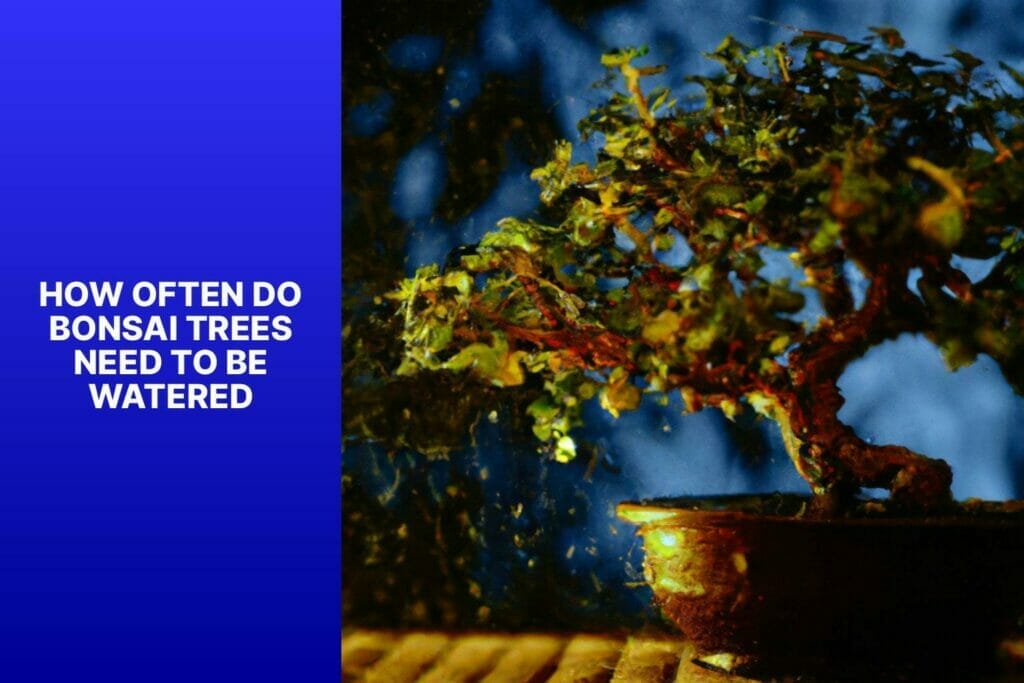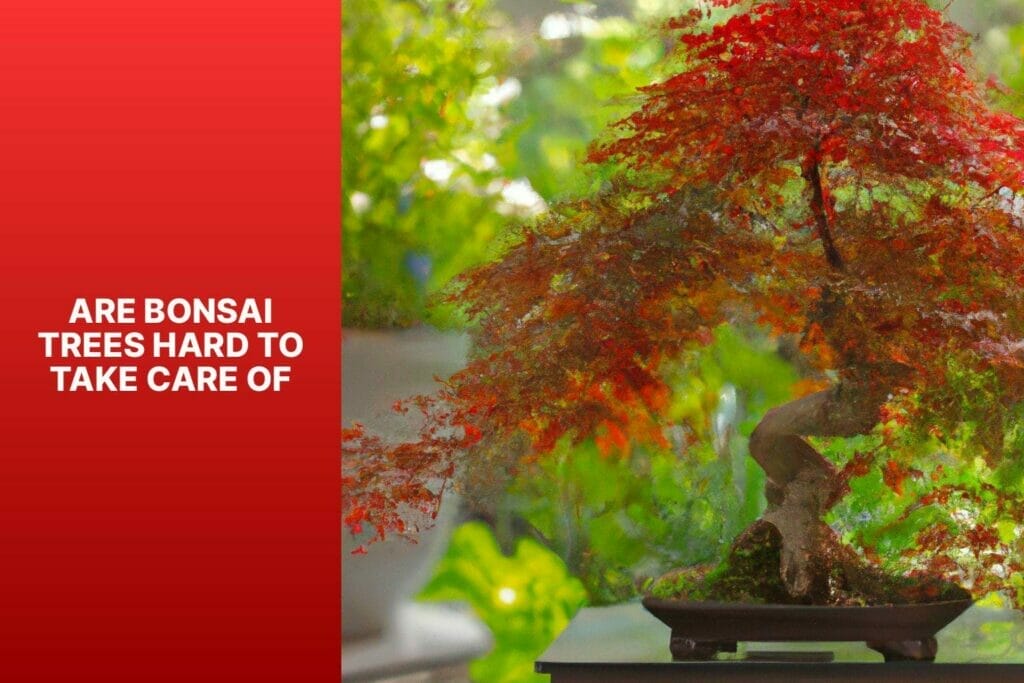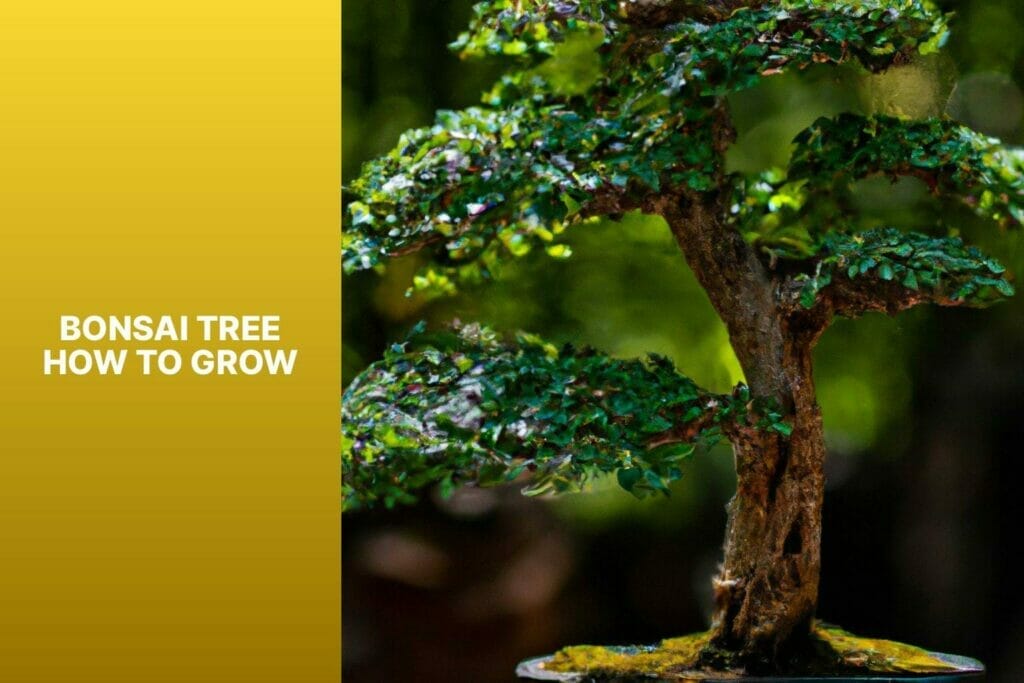Bonsai trees are miniature trees grown and shaped in containers, creating a unique and captivating art form. Proper care, including watering, is essential to ensure the health and longevity of these delicate trees.
Understanding how often bonsai trees need to be watered is crucial in maintaining their well-being.
Watering plays a vital role in the health of bonsai trees, as it provides the necessary hydration for their growth and development. Adequate water supply ensures that the Bonsai receive the necessary nutrients and minerals from the soil, promoting their overall health and vitality.
The frequency of watering bonsai trees depends on several factors. The type of bonsai tree, climate and weather conditions, the size of the bonsai pot, and the composition of the soil and its drainage capacity all play a role in determining the watering needs of bonsai trees.
To determine the frequency of watering, observation is key. Monitoring the soil’s moisture level and checking for signs of overwatering or underwatering are important practices for maintaining the proper balance.
General guidelines for watering bonsai trees can serve as a starting point to establish a watering routine.
Overwatering and underwatering can both be detrimental to the health of bonsai trees. Signs of overwatering include yellowing or dropping leaves, root rot, and fungus or mold.
On the other hand, signs of underwatering may include dry and brittle leaves, wilting, and stunted growth.
Several watering techniques can be employed for bonsai trees, such as the top-down watering method, submerging or soaking method, or using moisture meters to measure the moisture content of the soil accurately.
Key takeaway:
- Proper watering is essential for bonsai trees: Watering is crucial for the health and survival of bonsai trees, as it provides them with the necessary hydration for growth and development.
- Watering frequency depends on various factors: The type of bonsai tree, climate and weather conditions, size of the bonsai pot, and soil composition and drainage all play a role in determining how often bonsai trees should be watered.
- Observation and general guidelines help determine optimal watering: By closely observing the bonsai tree and following general guidelines, enthusiasts can maintain the right moisture balance, avoiding overwatering and underwatering.
Importance of Proper Watering for Bonsai Trees
Proper watering is of utmost importance for ensuring the well-being and growth of bonsai trees. The significance of water lies in its role in vital processes such as photosynthesis, nutrient absorption, and maintaining turgidity.
To guarantee proper watering, the following steps should be followed:
- It is crucial to water the trees adequately and regularly to prevent dehydration and the occurrence of wilted leaves.
- Thoroughly watering the trees ensures water reaches the entire root system.
- Both overwatering and underwatering should be avoided as they can harm the trees.
- Factors such as soil type, climate, and season determine watering frequency.
- In most cases, bonsai trees should be watered when the top layer of soil feels slightly dry.
- To prevent damage to the delicate tree structure, it is recommended to use a gentle and fine spray for watering.
- Consider using a moisture meter to measure soil moisture accurately.
- Proper drainage is essential to prevent waterlogging and diseases like root rot.
Let me share a true story: I once had a magnificent bonsai tree that I diligently cared for. Unfortunately, I unintentionally neglected to water it for an extended period due to my busy schedule.
As a result, the tree started showing signs of distress, with yellowing and falling leaves. Realizing my mistake, I thoroughly watered the tree and relocated it.
Over time, the bonsai tree started to recover, and its vibrant leaves emerged. This experience taught me the significance of proper watering for the health and vitality of bonsai trees.
Why is Watering Essential for Bonsai Trees?
Watering is essential for bonsai trees as it plays a vital role in their health and growth. Here are the reasons why:
1. Moisture supply: Like all plants, bonsai trees need water to survive. Water hydrates the tree’s cells, keeping them functioning properly. Without sufficient water, the tree can become dehydrated and die.
2. Nutrient absorption: Water is a carrier for essential nutrients in the soil. Through osmosis, the bonsai tree’s roots absorb these nutrients and water, ensuring proper growth and development.
3. Maintaining turgidity: Water helps the bonsai tree’s cells maintain their structure and support. Without enough water, leaves, and branches may wilt, affecting the tree’s overall aesthetic appeal.
4. Temperature regulation: Watering helps regulate the bonsai tree’s temperature. In hot weather, water evaporation through transpiration cools down the tree. It also insulates the roots from extreme temperatures during winter.
5. Preventing stress: Proper watering prevents stress caused by underwatering or overwatering. Consistent and appropriate watering ensures the roots have enough water without being exposed to excess moisture, promoting a healthy root system.
To achieve optimal growth and longevity, it is essential to understand the specific needs of each bonsai tree and use proper watering techniques.
How Does Watering Impact the Health of Bonsai Trees?
Watering is crucial for the health of bonsai trees. It provides essential nutrients to the roots, preventing dehydration and regulating temperature. Watering also facilitates oxygen absorption and promotes nutrient absorption.
It helps prevent diseases and regulates the growth of the tree. Understanding the impact of watering is essential for successful bonsai cultivation, as it promotes healthy growth and maintains the beauty of the trees.
How Does Watering Impact the Health of Bonsai Trees?
Factors to Consider When Watering Bonsai Trees
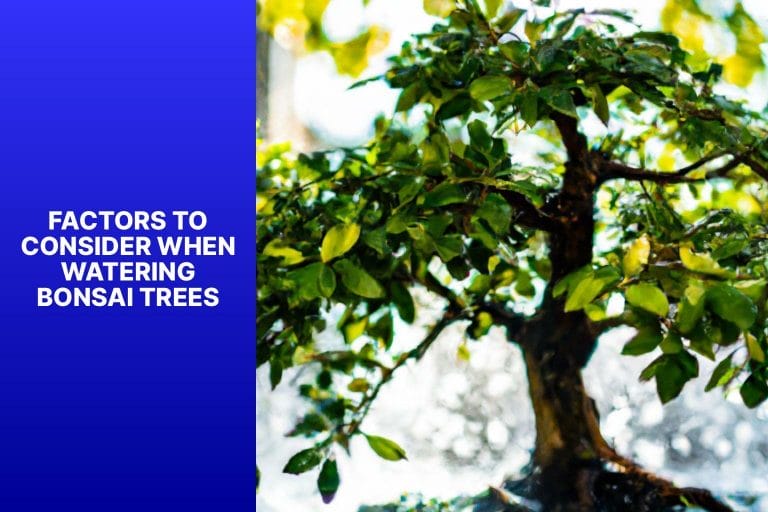
Photo Credits: Mnbonsainetwork.Com by Richard Thompson
When watering bonsai trees, there are several factors to consider. From the type of bonsai tree and climate conditions to the size of the pot and soil composition, each element plays a crucial role in maintaining the right moisture balance.
Understanding these factors will help ensure the health and longevity of your bonsai tree. So, let’s dive into the key considerations that impact the watering needs of bonsai trees.
Type of Bonsai Tree
The type of bonsai tree you choose is crucial in its care. Different types have varying characteristics and requirements. Here is a table that provides information on the types of bonsai trees and their traits:
| Type of Bonsai Tree | Description | Ideal Climate | Soil Preference |
|---|---|---|---|
| Juniper | Vibrant green foliage and twisted trunks. Highly adaptable and can thrive in various climates. | Can tolerate both cold and warm climates. | Well-draining soil mixtures. |
| Pine | Long needles and graceful branches. I prefer climates with cool winters and mild summers. | Cool to moderate climates. | Soil with good drainage and acidity. |
| Maple | Stunning autumn foliage and intricate branch structures. Thrives in temperate climates. | Moderate climates with well-defined seasons. | Loamy soil with good drainage. |
| Elm | Delicate and elegant leaves. Can tolerate a wide range of climates. | Can adapt to both warm and cool climates. | Well-draining soil with organic matter. |
| Ficus | Glossy leaves and a robust root system. Well-suited for indoor environments. | Warm and humid climates. | Well-draining soil mixtures. |
When selecting a bonsai tree, consider the type that best suits your climate conditions and the intended environment.
Understanding the specific requirements of each type will help you provide appropriate care and enhance its health and appearance.
Research and consult knowledgeable sources for the best results in cultivating your bonsai tree.
Climate and Weather Conditions
Climate and weather conditions play a vital role in caring for bonsai trees. It is important to consider your region’s specific climate and weather patterns regarding watering.
1. Adjusting the watering schedule according to the climate is crucial. In hot and dry climates, bonsai trees need to be watered more frequently to prevent them from drying out. Conversely, watering should be done less often in cooler and more humid climates to avoid overwatering.
2. Extreme weather conditions can have an impact on the watering requirements. For instance, the soil retains more moisture during heavy rain or high humidity, resulting in less frequent watering. On the other hand, during hot and dry periods, it is necessary to water more frequently to ensure the bonsai tree is adequately hydrated.
3. It is important to regularly check the soil’s moisture level to adjust the watering routine accordingly. Climate and weather conditions determine how quickly the soil dries out. You can provide the bonsai tree with the appropriate amount of water by monitoring the soil moisture.
4. The amount of wind and direct sunlight also affects the rate of moisture loss. Bonsai trees in windy and sunny locations will experience increased evaporation, necessitating more frequent watering.
By considering your area’s specific climate and weather conditions, you can adapt your watering routine to promote the health and vitality of your bonsai tree.
Size of Bonsai Pot
–
The size of the bonsai pot is a crucial consideration. When choosing a pot, it is important to consider several key factors.
–
One factor is providing adequate space for the roots to spread and grow. The tree’s health can be affected if the pot is too small and hinders root development.
–
It is important to consider the proportionality between the pot and the size of the bonsai tree. A large tree in a small pot can create an unbalanced appearance, while a small tree in a large pot may seem disproportionate.
–
Another important factor is ensuring the pot’s stability, especially in outdoor environments with wind and other elements.
–
Good drainage is crucial for the health of the bonsai tree. The pot should have holes at the bottom to prevent water accumulation and root rot.
–
Considering these factors, you can ensure that the bonsai pot’s size is appropriate for the tree’s growth and aesthetic appeal.
Soil Composition and Drainage
Soil composition and drainage are critical aspects of caring for bonsai trees. The tree’s health is directly influenced by the type of soil it is planted in and its ability to drain water.
Using well-draining soil for bonsai trees is essential to prevent root rot and other water-related diseases.
To achieve the right soil composition, blending organic materials such as peat moss or compost with inorganic materials like coarse sand or perlite is recommended.
Organic materials retain moisture and provide nutrients, while inorganic materials enhance drainage and prevent soil compaction.
In addition to the soil composition, proper drainage in the bonsai pot is equally important. Ensuring the pot has multiple drainage holes at the bottom is advised to allow smooth water flow.
To keep the bonsai tree healthy, it is crucial to monitor the moisture levels in the soil regularly. Watering the tree should be done when the top layer of soil feels slightly dry.
Overwatering should be avoided to prevent root suffocation and maintain the tree’s overall health.
How Often Should Bonsai Trees Be Watered?
Discover the secrets to keeping your bonsai trees thriving with just enough water. This section explores the essential question: how often should bonsai trees be watered?
By observing your trees’ needs and following some general guidelines, you’ll learn the art of striking a perfect balance between hydration and drainage.
Get ready to uncover the key factors that will ensure the health and longevity of your cherished bonsai collection.
Determining Watering Frequency Through Observation
1. Observe soil moisture: To determine the watering frequency for your bonsai tree, start by checking the soil moisture. Insert your finger about an inch deep into the soil. If the soil feels dry, it means it needs watering. On the other hand, if it feels wet, it is overwatered.
2. Watch for leaf drooping: Leaf drooping or wilting is a sign of underwatering. Adjust the frequency of watering to provide sufficient moisture to your bonsai tree.
3. Consider tree type: Different bonsai tree types have varying water requirements. Tropical bonsai trees need more frequent watering, while conifers require less. Researching your bonsai tree’s specific needs is important to determine the appropriate watering frequency.
4. Account for climate and weather conditions: Climate and weather conditions also significantly determine the watering frequency. Hot and dry weather may require more frequent watering, while cooler and humid conditions may require less. It is essential to adjust the watering accordingly.
5. Pay attention to evaporation rates: Water evaporates quicker in warmer or drier environments, leading to faster soil drying. Consider this factor when determining the watering frequency for your bonsai tree.
Suggestions:
– Establish a watering routine that suits your bonsai tree’s specific needs.
– Regularly monitor the soil moisture and make adjustments as necessary.
– Water your Bonsai thoroughly, but avoid overwatering to prevent root rot.
– Understanding your bonsai tree’s watering needs is essential for its health and vitality.
General Guidelines for Watering Bonsai Trees
Following these general watering guidelines is important to ensure their health and well-being when caring for bonsai trees. First, monitor the soil moisture and water frequency appropriately.
Thoroughly water the bonsai trees when the topsoil feels slightly dry. The watering frequency may vary depending on factors such as the type of bonsai tree, climate conditions, and pot size.
Next, use the top-down watering technique to reach the roots evenly. Be careful not to apply excessive force that could disturb the soil and potentially harm the tree.
By using this method, you can ensure that the water is distributed evenly throughout the root system.
Ensure that excess water drains from the bottom of the pot to hydrate the entire root system adequately. To prevent water pooling and root rot, it is essential to use pots with sufficient drainage holes.
The soil used should be well-draining, allowing excess water to flow freely.
Regularly check the soil moisture using either a finger or a moisture meter. By observing the moisture level, you can adjust the watering frequency according to the specific needs of your bonsai tree.
This enables you to provide the appropriate amount of water and maintain its hydration, growth, and vitality.
By following these general guidelines for watering bonsai trees, you can develop a suitable routine and understand the specific watering requirements of your tree over time.
Signs of Overwatering or Underwatering Bonsai Trees
Bonsai trees require careful attention, and watering is crucial to their care. This section will explore the signs indicating whether a bonsai tree is suffering from overwatering or underwatering.
By understanding these indicators, you can ensure the optimal watering schedule for your Bonsai, preventing potential damage and promoting its healthy growth. So, let’s dive in and learn to read nature’s signs!
Signs of Overwatering
– Yellowing leaves: One of the signs of overwatering in bonsai trees is yellowing leaves. This occurs because consistently saturated roots deprive the leaves of oxygen, causing them to turn yellow.
– Wilting foliage: Another indication of overwatered bonsai trees is wilting foliage. When the roots are waterlogged, they cannot effectively absorb nutrients, resulting in a lack of moisture and nutrients reaching the leaves, causing them to wilt.
– Mushy or rotten roots: Overwatering can cause the roots of bonsai trees to become mushy or rotten. It may indicate overwatering if you notice a strong, unpleasant odor from the soil or if the roots feel mushy when touched. Excess water can lead to root rot, which is detrimental to the health of the bonsai tree.
– Slow growth or stunted development: Impeded growth and stunted development are common signs of overwatering in bonsai trees. If your tree is not growing vigorously or new branches and leaves are not emerging, it could result from overwatering.
– Mold or fungus growth: Excessive moisture in the soil creates a favorable environment for mold and fungus growth. When overwatering occurs, you may notice the presence of mold or fungus on the soil surface or around the base of the bonsai tree. This can be a clear sign of overwatering.
Signs of Underwatering
Signs of Underwatering
The signs of underwatering in bonsai trees are easy to identify. Here are some indicators that your bonsai tree may be underwatered:
- Wilting leaves: When a bonsai tree lacks water, its leaves wilt and become dry.
- Yellow or brown leaves: Underwatered bonsai trees may have yellow or brown leaves due to a lack of moisture.
- Dry soil: If the soil in your bonsai pot feels dry, it’s a clear sign that your tree needs more water.
- Slow growth: Insufficient watering can stunt the growth of your bonsai tree.
- Brittle branches: When a bonsai tree is underwatered, its branches may become brittle and prone to breaking because the lack of water weakens the tree’s structure.
To prevent underwatering your bonsai tree, ensure thorough and regular watering. Monitor the soil moisture and adjust the watering frequency accordingly.
Remember, it is better to slightly underwater than overwater your bonsai tree.
Watering Techniques for Bonsai Trees
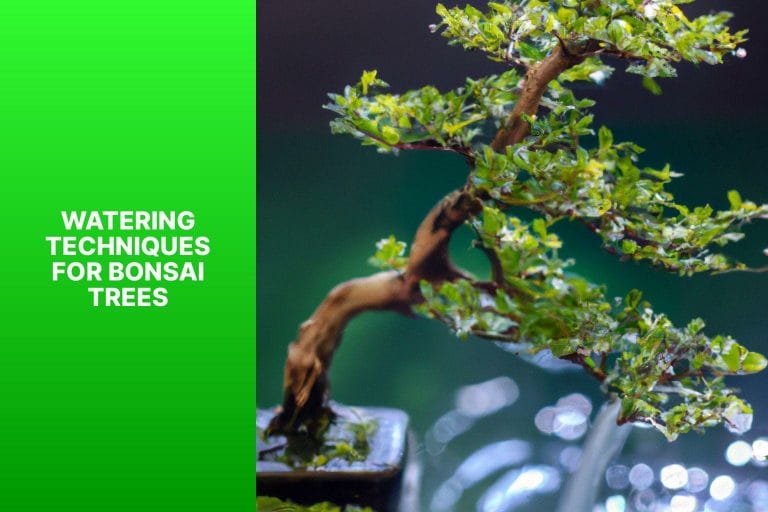
Photo Credits: Mnbonsainetwork.Com by Kenneth Lee
Discover the art of watering bonsai trees with finesse! This section explores different watering techniques to ensure your bonsai creations’ health and vitality.
From the top-down method to submerging or soaking techniques, we’ll explore various ways to quench your Bonsai’s thirst.
We’ll even touch upon the usefulness of moisture meters in finding that perfect balance. Get ready to nourish your Bonsai with precision and unleash its full potential!
Top-Down Watering Method
The top-down watering method, or the Top-Down Watering Method, is a well-known and widely practiced technique for watering bonsai trees.
This popular method involves pouring water onto the soil surface from the top, allowing it to percolate through the entire root system slowly.
You can properly water your bonsai tree by following a few simple steps.
To begin, position your bonsai tree in a sink or shallow container. This will help contain any excess water that drains out during the watering process.
Next, select a watering can with a fine nozzle or a small vessel with a narrow spout. These tools will allow you to gently pour the water onto the soil surface, starting from one side and gradually moving across the entire pot.
It’s important to ensure thorough coverage of the soil.
When watering your bonsai tree using the top-down method, it’s crucial to avoid pouring water directly onto the foliage.
This precaution helps prevent the development of fungal diseases. Instead, focus on pouring the water onto the soil surface to ensure it reaches the root system.
Continue watering until water starts draining out from the pot’s bottom. This step is vital in providing adequate moisture to the entire root system of the bonsai tree.
Once you’ve finished watering, allow any excess water to drain completely before returning the bonsai tree to its display location.
This ensures the tree won’t sit in standing water and potentially suffer from root rot.
The top-down watering method offers several benefits to bonsai trees. Mimicking natural rainfall promotes deep root growth and efficient water distribution throughout the root system.
This method helps prevent water accumulation on the soil surface, reducing the risk of root rot.
It’s important to adjust the watering frequency based on factors such as the type of bonsai tree, climate conditions, and moisture needs of the specific species.
Before watering, always check the tree and soil moisture levels to avoid overwatering or underwatering.
Originating centuries ago from the wisdom of Asian bonsai masters, the top-down watering method has become essential in bonsai care.
Its effectiveness in evenly saturating the soil and reaching the entire root system ensures the health and vitality of these miniature trees.
Today, bonsai enthusiasts from all around the world widely practice this technique to nurture their bonsai trees.
Incorporating the top-down watering method into your bonsai care routine will help you provide the optimal moisture level for your trees, promoting their overall well-being and longevity.
Submerging or Soaking Method
The submerging or soaking method, or submersion, is a popular technique used to water bonsai trees. This method ensures the roots receive adequate water for their growth and health.
To utilize this method, fill a basin or container with water. Then, gently submerge the bonsai pot into the water until it reaches the rim. Allow the pot to soak in the water for 5 to 10 minutes.
As the pot soaks, water seeps into it through the drainage holes, effectively hydrating the soil and roots of the bonsai tree. After the soaking period, carefully remove the pot and allow any excess water to drain out.
Place the Bonsai back in its designated spot, ensuring proper drainage for the excess water. This will ensure that the bonsai tree continues to thrive and remain well-hydrated.
The submerging or soaking method is especially beneficial during hot summers or drought conditions. It provides deep and thorough watering, ensuring that the roots of the bonsai tree remain well-hydrated and healthy.
Using Moisture Meters
Using moisture meters is an effective way to ensure proper hydration for bonsai trees. Here are the steps to follow:
- Select a high-quality moisture meter designed for measuring soil moisture in bonsai trees. Look for a meter with reliable accuracy.
- Insert the moisture meter probe into the soil, reaching the root level. Be gentle to avoid damaging the roots.
- Wait a few seconds for the moisture meter to take a reading. Most moisture meters have a digital display showing the moisture level.
- Interpret the moisture level reading. If the meter indicates dry soil, it’s an indication that watering is needed. If the reading shows high moisture levels, the soil is adequately hydrated.
- Water the bonsai tree based on the moisture level reading. If the soil is dry, water the tree until the water begins to drain from the bottom of the pot. If the soil is already moist, hold off on watering until the moisture level decreases.
- Repeat the moisture meter reading regularly to monitor hydration levels and adjust the watering frequency.
A moisture meter eliminates guesswork when watering bonsai trees and helps prevent overwatering or underwatering.
By accurately assessing moisture levels, you can ensure optimal growing conditions for your bonsai tree and promote its overall health and vitality.
Tips for Successful Watering of Bonsai Trees
Here are some tips for watering bonsai trees:
1. Observe the soil: Check the soil’s moisture level before watering your bonsai tree. Insert your finger about an inch deep into the soil to check if it is dry.
2. Water as needed: Bonsai trees require regular watering, but the frequency depends on factors such as climate, humidity, and the type of bonsai tree. Water the tree when the soil feels slightly dry to the touch.
3. Water thoroughly: When watering your bonsai tree, ensure the water comes from the drainage holes at the bottom of the pot. This ensures that the roots receive sufficient moisture.
4. Avoid overwatering: Overwatering can cause root rot and other issues. Provide the right amount of water for your bonsai tree, allowing the soil to dry slightly between waterings.
5. Use the right watering technique: Water the bonsai tree in a circular motion around the trunk to ensure even distribution. Avoid pouring water directly onto the foliage to prevent fungal problems.
6. Consider humidity levels: Bonsai trees thrive in environments with moderate humidity. If you live in a dry climate, enhance humidity with a humidity tray or occasional leaf misting.
7. Adjust watering based on seasons: The watering needs of your bonsai tree may vary with seasonal changes. Water more frequently during warmer months and reduce watering during colder months.
Some Facts About How Often Bonsai Trees Need to Be Watered:
- ✅ Bonsai trees should never be allowed to dry out completely.
- ✅ It is recommended to wait for the soil to become slightly dry before watering.
- ✅ Thorough watering is important to reach the entire root mass of the bonsai tree.
- ✅ There is no exact guide for watering frequency, so it is important to observe each tree individually.
- ✅ Online courses are available to learn about the art of Bonsai and proper watering techniques from leading experts.
